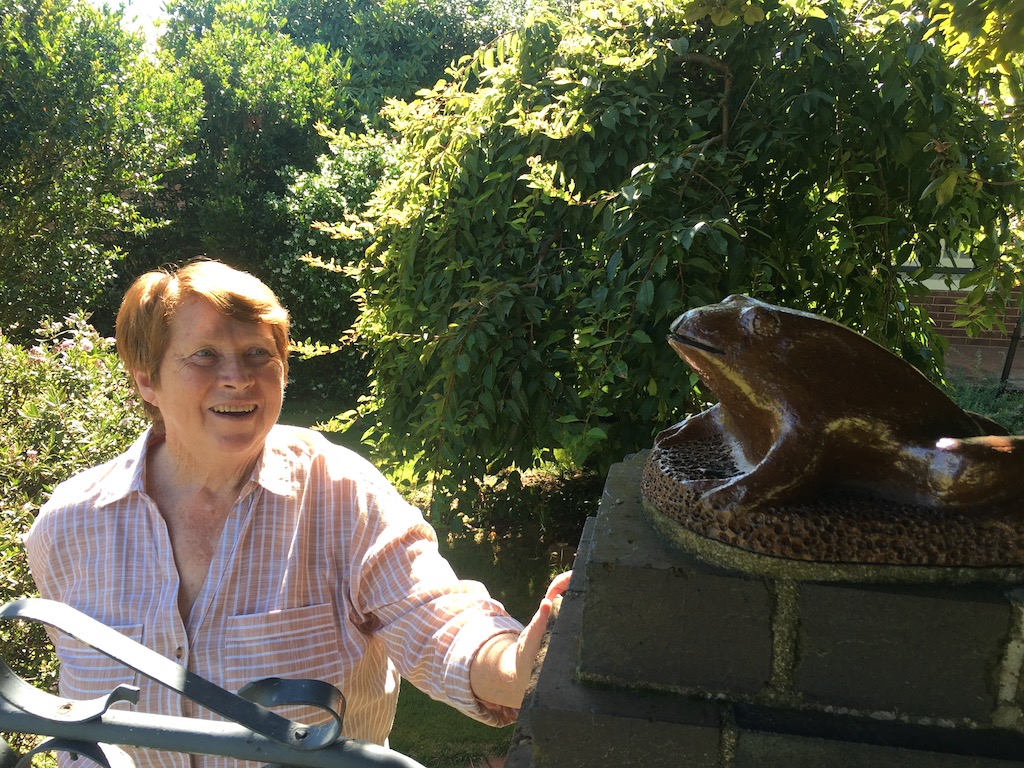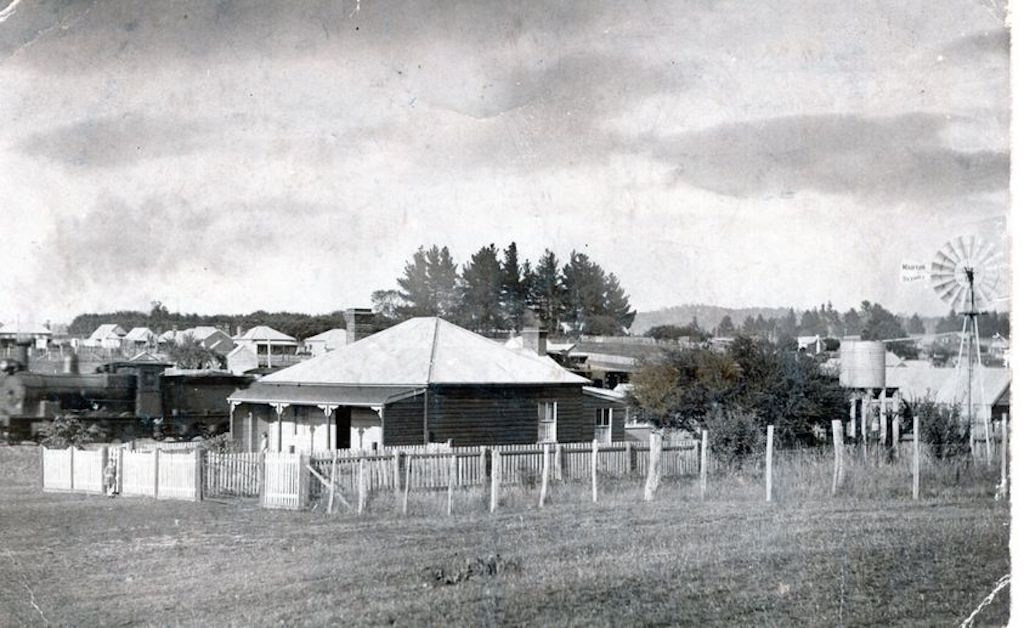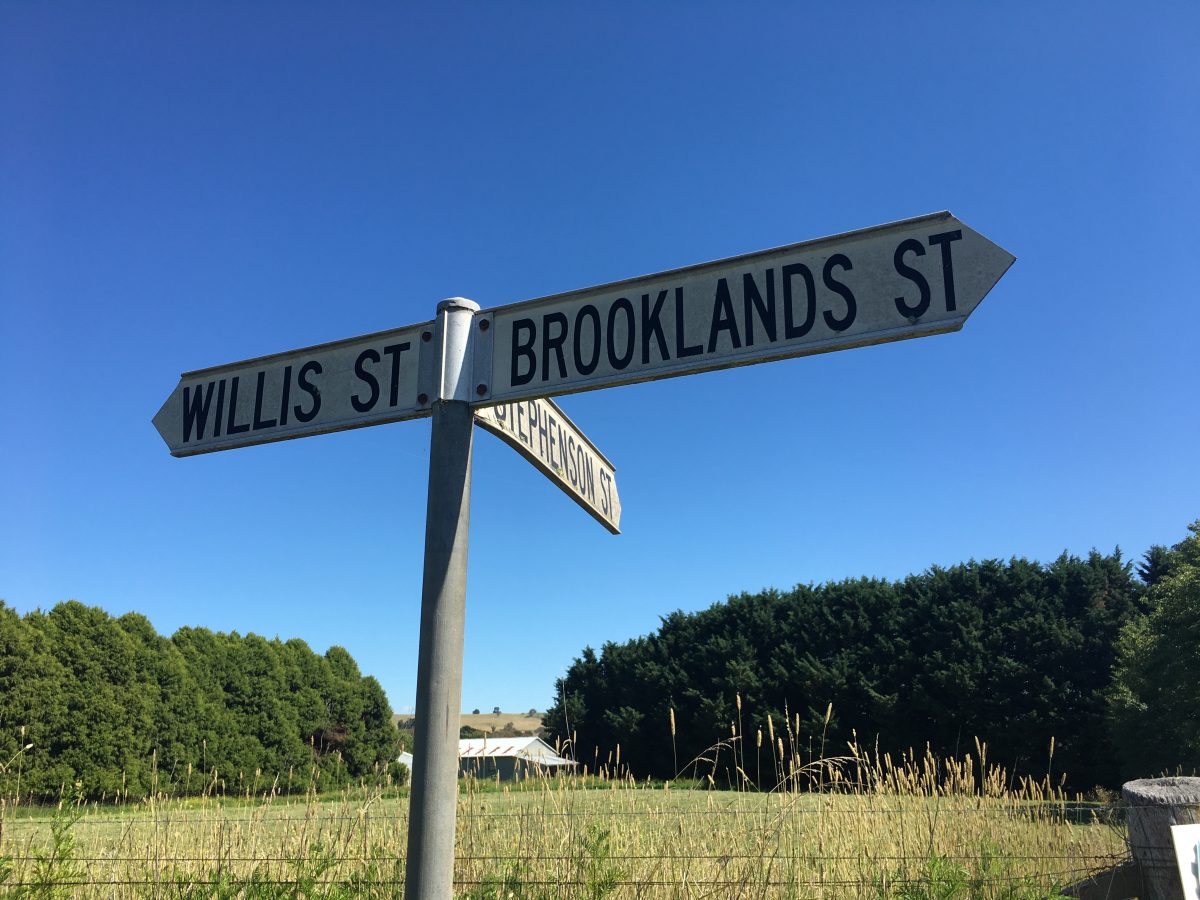
Jenny Skelly with a Willis frog on her gatepost in Stephenson Street, Crookwell. She is keen to hear from anyone who can repair one of her frogs. Photo: John Thistleton.
Like the traditional brickmakers leaving an indent called a frog on one side of their bricks, Crookwell’s Willis family left a frog atop either side of the gate entrances and fence tops outside their homes in Stephenson Street.
Moulded in the shape of an amphibian frog rather than a brick indent, they represent an extraordinary extended family of brickmakers and link three of the homes in Stephenson Street and another in nearby Tait Street, which accommodated the early Willis families, who operated a brick pit, workshop and kilns further along Stephenson Street.
Jenny Skelly, who has lived with husband Garry in one of the Stephenson Street homes for more than 50 years, said the double-brick residences with brick foundations from the ground up (rather than sitting on stumps) had curved bricks around the doorways and two bands of darker-coloured bricks around the exterior.
Willis bricks can be found in a 650-metre-long railway tunnel near Mittagong (used as a mushroom farm these days), and Goulburn’s railway viaduct over the Mulwaree River. Generations of the family made and laid bricks from Bowral to Bathurst, Goulburn, Tarago, Wagga and beyond for the Railway Department, banks, churches, shops and numerous homes.
Their prolific brickmaking resurfaced when family descendant Dell Bungay recently shared on social media images of their solid homes and commercial buildings in Crookwell.
This sparked Garry Stephenson’s memories of his father Wally working for Alf Willis in the 1940s, and growing up in Stephenson Street.
A professional shearer who travelled to Queensland and northern NSW to work, Wally always knew Alf had a job at the brickworks waiting for him on his return home.
“Dad spent a fair bit of his time collecting wood for the kilns in daylight hours and carting wood from a property on the Grabben Gullen Road,” Garry said.
He remembers at least four brick kilns were shaped like a Nissan hut with bricks laid at both ends to retain the heat inside and make them fireproof.
Aside from collecting wood, Wally would take the pressed bricks and stack them in the kiln, then prepare them to fire.
“There was a fair bit of manual work that went on there,” Garry said. “When the bricks were stacked in the kiln, they had to have a certain amount of gap between them so heat could get between them and cook the bricks.”

“Winston Hill”, corner of Harley Road and Prospect Street, the home of Charles Allen and Emily Willis. Note the steam behind the home. Photo: Dell Bungay.
Nearby on Grabben Gullen Road, Leon and Gordon Willis worked in the family’s large apple, pear and cherry orchard.
The family’s brick legacy began when brickmaker Timothy Willis came to Australia in 1839 from Kent, England, and moved to Bowral in 1863. Three of his and wife Sarah’s 12 children, George, Charles and John, carried on the brickmaking and bricklaying tradition.
Charles worked on many railway projects before moving to Crookwell in 1887 with his wife Hannah and son Herbert. Selecting a property covered in white clover, he named it ”Cloverleigh”, cleared land, continued his trade as a bricklayer and established the apple orchard. He handed his property to his son Alick in 1922.
John Willis came to Crookwell when he was 15 and later moved to Tarago, making bricks for the railway. Moving again to Goulburn, he made bricks for Goulburn Jail before returning to Crookwell and setting up his own business as a brickmaker. The business thrived.
“It was his proud boast that some of the finest structures in Auburn Street, Goulburn, were constructed from bricks from his kilns,” his obituary in the Crookwell Gazette reported in 1940. He and his wife Ann had 11 children, including a son, Alfred.
Grandson Barry Croker said Alf, who had been raised during the Depression and improvised with what he had to keep the brickworks going, left the business due to ill health in the 1950s.

This Willis Street sign is a more recent name added to a section of Grabben Gullen Road. The family operated brickworks at Stephenson Street, running off Willis Street, Crookwell. Photo: John Thistleton.
“He handed the business over to my uncle Noel [Alfred Noel Willis],” Barry said. ”Uncle Noel ran it for 10 years, I suppose. It became rundown and unviable. The brickworks were too small and too old-fashioned. He sold the land to Leon Willis.”
Willis’ descendants left lasting and well-recorded legacies for Crookwell, while the frogs continue forming a silent reminder of these industrious brickmakers.
Original Article published by John Thistleton on About Regional.












